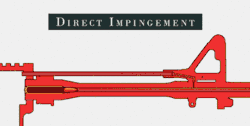Direct impingement
Direct impingement is a type of gas operation for a firearm that directs gas from a fired cartridge directly into the bolt carrier or slide assembly to cycle the action.
Evaluation
Firearms featuring a direct impingement design tend to be lighter and shorter, but, are also dirtier, due to the exposure of the firearm's internal moving parts to fouling from cartridge propellant gases. Such firearms are thus potentially less reliable as a result.
Unlike conventional gas-operated firearms, direct impingement does away with a separate gas cylinder, piston, and operating rod assembly. High-pressure gas acts directly upon the bolt and carrier thereby saving weight, lowering manufacturing costs, and reducing the mass of the operating parts, and thereby the wear on mechanical parts due to movement. By removing the gas piston, the potential amount of moving mass is lowered, thus decreasing the potential for a disrupted sight picture.

The main disadvantage of direct impingement is that the breech of the firearm's firing mechanism becomes fouled more quickly due to being exposed to the residues of the burned cartridge propellant. This is caused by particles suspended in high-temperature gas condensing on the bolt face and primary operating mechanism. The combustion gases contain vaporized metals, carbon, and impurities in a gaseous state until they contact the relatively cooler operating parts. These deposits increase friction on the bolt's camming system leading to malfunctions, so that frequent and thorough cleaning is required to ensure reliability. The amount of fouling depends upon the rifle's design as well as the type of propellant powder used. For example, the French MAS 44 and MAS 49 series of rifles was known to have been successfully operated for years with corrosive-primed ammunition using ordinary field cleaning expedients such as gasoline (as solvent) and straight-grade motor oil (as lubricant)..
A further disadvantage of direct impingement is that combustion gases heat the bolt and bolt carrier as the firearm operates. This heating causes essential lubricant to be "burned off". Lack of proper lubrication is the most common source of weapon malfunctions. These combined factors reduce service life of these parts, reliability, and mean time between failures.[1]
The operation of the system is highly dependent on the length of both barrel and gas tube which transports gas from the barrel to the bolt. Using too short a gas tube can result in increased pressure inside the bolt assembly and increased rate of automatic fire, both of which can have detrimental effect on the weapon and accuracy of shots. The use of a suppressor also increases gas pressure, further aggravating the situation. The problem can be reduced by using a longer gas tube, moving the gas port on the barrel further forward, and/or by installing an adjustable gas block to provide the right amount of gas pressure depending on the desired operating mode.
History
The first experimental rifle using a direct impingement system was the French Rossignol ENT B1 automatic rifle followed by Rossignol's B2, B4 and B5. The first successful production weapon was the MAS 40 rifle adopted in March 1940. The Swedish Ag m/42 is another well-known example. Both the French and Swedish rifles use a simple system whereby the gas tube acts as a piston with a cylinder recess in the bolt carrier.
The original AR-10 action (later developed into the ArmaLite AR-15 and M16 rifle) designed by Eugene Stoner is commonly called a direct impingement system, but it does not utilize a conventional direct impingement system. In U.S. Patent 2,951,424, the designer states: ″This invention is a true expanding gas system instead of the conventional impinging gas system.″ [2] Gas is routed from a port in the barrel through a gas tube, directly to a chamber inside the bolt carrier. The bolt within the bolt carrier is fitted with piston rings to contain the gas. In effect, the bolt and carrier act as a gas piston and cylinder.
See also
References
- ↑ Major Thomas P. Ehrhart Increasing Small Arms Lethality in Afghanistan: Taking Back the Infantry Half-Kilometer. US Army. 2009
- ↑ "Patent US2951424 - GAS OPERATED BOLT AND CARRIER SYSTEM". Google.com. Retrieved 2013-04-11.
Sources
- Centre des archives de l'armement, Châtellerault. National Armament Archives Center.
- Huon, Jean. Proud Promise—French Semiautomatic Rifles: 1898-1979, Collector Grade Publications,1995, ISBN 0-88935-186-4
- United States Patent Office, Patent No. 2951424 - Gas Operated Bolt and Carrier System, Sep 6 1960.